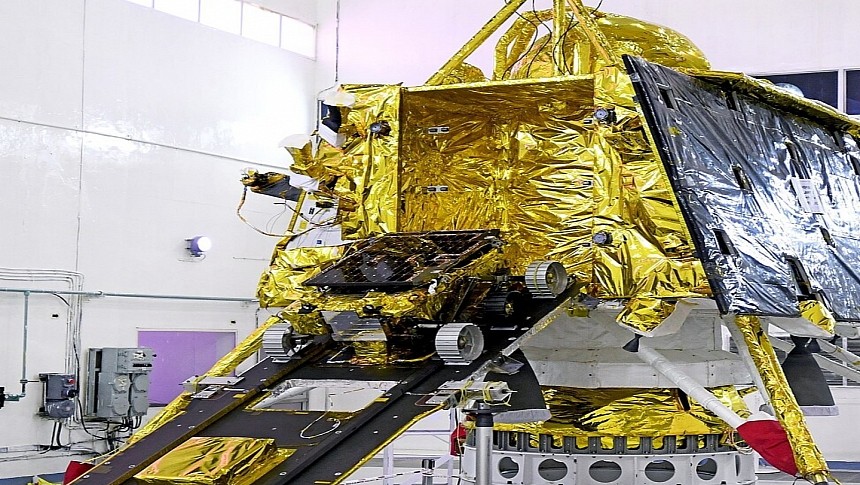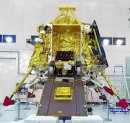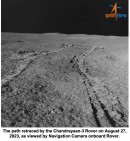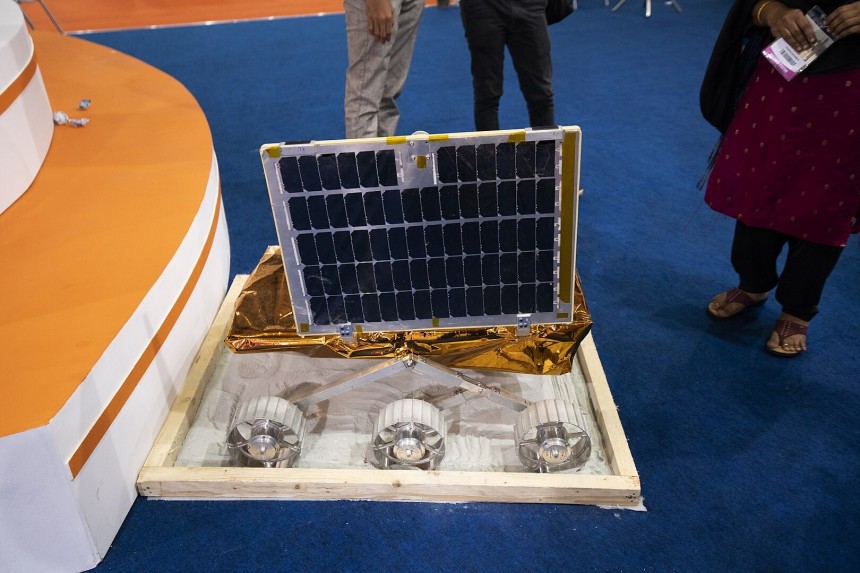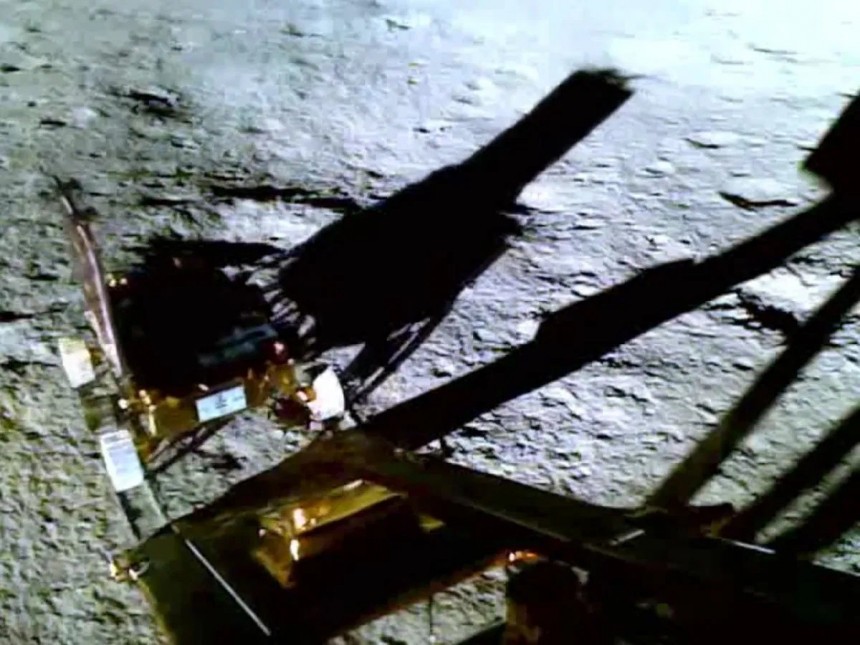For far too long, wide-scale space exploration was a practice gate kept by the world's preeminent superpowers. Be it the Soviets, the Russians after that, the Chinese, and, of course, the United States, only countries with enough economic clout and geopolitical influence had the luxury of sending probes to space. Though still true to a degree, the short list of space-fairing nations with probes exploring other heavenly bodies just got slightly longer thanks to India's Chandrayaan-3 mission.
But of all the technology aboard this unique and fascinating spacecraft, the Pragyan lunar rover might be the most exciting. As the first wheeled vehicle to explore the ostensibly resource-rich regions around the Lunar South Pole, Pragyan serves as an impact statement to all the world's major space agencies. Of course, this statement is that India will soon be just as big a player in the second space race as Russia, China, Japan, and even the US. Today, let's take a deep dive into the inner workings of India's first successful Moon rover to uncover what makes it so darn special.
A product of the Indian Space Research Organization (ISRO), the Chandrayaan-3 mission was far from the first attempt at an Indian presence in deep space. The organization's first low-Earth orbit observation probe, the Aryabhata satellite, was launched aboard a Kosmos 3M rocket out of the Soviet Kapustin Yar launch complex in 1975. Two more probes, the twin Bhaskara satellites, were launched in 1979. Since then, the ISRO has gradually increased its presence in the international science community, having collaborated with more established international space agencies like Roscosmos, the ESA, and NASA.
As the 20th century passed, the ISRO's primary focus became the in-house development of its space probe and booster rocket technology. One such milestone was advancements like India's first domestic space launch facility on the Sriharikota off the Bay of Bengal. Today, this facility is called Satish Dhawan Space Centre. Over the years, the agency developed various bespoke, in-house-manufactured launch vehicles to cut its reliance on foreign hardware. Valuable assets like the Geosynchronous Satellite Launch Vehicle (GSLV), the Polar Satellite Launch Vehicle (PSLV), and the modern Launch Vehicle Mark-3 make for a robust fleet of rockets for India's burgeoning space industry.
All that was needed was a novel space probe to mount inside said rockets. As far as lunar exploration was concerned, it all began with the Chandrayaan program. The first mission in this new lunar exploration initiative, Chandrayaan-1, was a relatively simple orbiter complete with an impactor element that detached from the probe and collided with the Lunar South Pole near Shackleton crater for scientists to analyze. It wasn't until 2019 that the ISRO launched its most ambitious space mission with Chandrayaan-2. This mission carried the first Indian-wheeled space-roving vehicle, Pragyan.
With dimensions of just under a meter long, three-quarters of a meter wide, and .85m tall (3.0ft × 2.5ft × 2.8ft) and weighing 27 kg (60 lbs), Pragyan (Sanskrit for "wisdom"), is only marginally bigger than NASA's Sojourner probe. That was the first human-built wheeled roving vehicle to traverse another planet, Mars, back in 1997. But it's considerably smaller than the 140-kg (310-lb) Yutu rovers sent by China to the Moon in 2013 and 2019, respectively. But don't let the size fool you; there's respectable technology shoved into each Pragyan chassis.
Central to the operation of Pragyan is what's known as a rocker-bogie suspension system, which uses two sets of rockers connected via a central differential to allow the rover's body to stay relatively level while its six wheels articulate over rough terrain. The system was first pioneered by NASA's twin Mars Exploration Rovers, Spirit and Opportunity, and has been used on every NASA Mars rover since. Inside Pragyan's body, each wheel is powered by a separate brushless DC electric motor like you'd find on contemporary RC drones and E-bikes here on Earth.
In a manner that almost resembles a military tank, Pragyan uses the differential force between its wheels on either side to steer itself rather than implement a complex and potentially fault-prone steering system. To observe its surroundings, Pragyan uses two monochrome one-megapixel camera system developed by the Indian Institute of Technology Kanpur in Central India to create a 3D digital terrain map of its immediate vicinity.
Though someone limited in its scientific capability in its current form, Pragyan would ultimately become the first space probe to land in the proverbial gold mine of valuable resources that is the Lunar South Pole. A region believed to be rich not only with minerals like iron and magnesium but also water ice and potentially even energy-rich helium-3 isotope. This honor wouldn't come without sacrifice. Chandrayaan-2, the first mission to carry Pragyan and its accompanying lander vehicle, called Vikram, failed in an incident shortly after separation from its orbiter on September 6th, 2019.
In what was later found to be an instance of software error, Chandrayaan-2's Vikram lander veered off course to the Lunar South Pole as it approached its landing sight some 350km (220 mi) north of South Pole–Aitken basin. The probe crashed roughly 500 meters from the intended landing site. The resulting wreck, strewn over several kilometers, was observed by NASA's Lunar Reconnaissance Orbiter shortly afterward. Nearly four years later to the date, the ISRO tried one more time to be the first to the Moon's South Pole with Chandrayaan-3. Launched on July 14th, 2023, aboard an LVM3 M4 launch vehicle, the spacecraft took its sweet time in low-Earth orbit before starting its cruise to the Moon on August 5th.
Chandrayaan-3 remained parked in lunar orbit until August 23rd. At this time, the Vikram lander with its Pragyan rover in tow separated from its orbiter vehicle, its destination being roughly 600 km (370 mi) from the Lunar South Pole between the craters Simpelius N and Manzinus C. Unlike the previous attempt, Chandrayaan-3's landing software held firm as Vikram's four decent engines carried the second Pragyan rover to a butter smooth landing. Unlike Apollo 11's landing, Chandrayaan-3 even had enough spare fuel to hover over the landing sight and pick the precise, most optimal spot to land and deploy its rover.
Later that same day, the second Pragyan rover made its first small steps for itself and a big, giant leap for India's presence in space by trundling onto this mostly unexplored piece of the lunar surface for the first time. Two and a half years before NASA plans to send humans to explore the same region of the Moon, it's India that will go down in the record books as the country that began the slow process to a human presence in the area. Though it did little but drive around for roughly 100 m (330 ft) before being put in sleep mode on September 3rd, this first expedition by humans to this section of the Moon is the inaugural for what might one day be a flood of activity.
For the moment, the second Pragyan rover remains on standby in sleep mode, its primary mission objective already complete. The probe's internals are not expected to survive the frigid lunar night cycle, a period that lasts up to two weeks. But, should the rover survive, the ISRO has implemented a feature that allows mission control to establish contact with Pragyan as soon as the lunar day shines on the region once again.
But even if contact can't be established, Chandrayaan-3's place in history is already established. From now until the end of recorded history, the history of lunar exploration in its south pole region will forever see the ISRO and the work of all its men and women as the spark that started it all. In a future where we're told humanity won't divide up the Moon over political boundaries. Adding another nation to the list can only be a positive.
A product of the Indian Space Research Organization (ISRO), the Chandrayaan-3 mission was far from the first attempt at an Indian presence in deep space. The organization's first low-Earth orbit observation probe, the Aryabhata satellite, was launched aboard a Kosmos 3M rocket out of the Soviet Kapustin Yar launch complex in 1975. Two more probes, the twin Bhaskara satellites, were launched in 1979. Since then, the ISRO has gradually increased its presence in the international science community, having collaborated with more established international space agencies like Roscosmos, the ESA, and NASA.
As the 20th century passed, the ISRO's primary focus became the in-house development of its space probe and booster rocket technology. One such milestone was advancements like India's first domestic space launch facility on the Sriharikota off the Bay of Bengal. Today, this facility is called Satish Dhawan Space Centre. Over the years, the agency developed various bespoke, in-house-manufactured launch vehicles to cut its reliance on foreign hardware. Valuable assets like the Geosynchronous Satellite Launch Vehicle (GSLV), the Polar Satellite Launch Vehicle (PSLV), and the modern Launch Vehicle Mark-3 make for a robust fleet of rockets for India's burgeoning space industry.
All that was needed was a novel space probe to mount inside said rockets. As far as lunar exploration was concerned, it all began with the Chandrayaan program. The first mission in this new lunar exploration initiative, Chandrayaan-1, was a relatively simple orbiter complete with an impactor element that detached from the probe and collided with the Lunar South Pole near Shackleton crater for scientists to analyze. It wasn't until 2019 that the ISRO launched its most ambitious space mission with Chandrayaan-2. This mission carried the first Indian-wheeled space-roving vehicle, Pragyan.
Central to the operation of Pragyan is what's known as a rocker-bogie suspension system, which uses two sets of rockers connected via a central differential to allow the rover's body to stay relatively level while its six wheels articulate over rough terrain. The system was first pioneered by NASA's twin Mars Exploration Rovers, Spirit and Opportunity, and has been used on every NASA Mars rover since. Inside Pragyan's body, each wheel is powered by a separate brushless DC electric motor like you'd find on contemporary RC drones and E-bikes here on Earth.
In a manner that almost resembles a military tank, Pragyan uses the differential force between its wheels on either side to steer itself rather than implement a complex and potentially fault-prone steering system. To observe its surroundings, Pragyan uses two monochrome one-megapixel camera system developed by the Indian Institute of Technology Kanpur in Central India to create a 3D digital terrain map of its immediate vicinity.
Though someone limited in its scientific capability in its current form, Pragyan would ultimately become the first space probe to land in the proverbial gold mine of valuable resources that is the Lunar South Pole. A region believed to be rich not only with minerals like iron and magnesium but also water ice and potentially even energy-rich helium-3 isotope. This honor wouldn't come without sacrifice. Chandrayaan-2, the first mission to carry Pragyan and its accompanying lander vehicle, called Vikram, failed in an incident shortly after separation from its orbiter on September 6th, 2019.
In what was later found to be an instance of software error, Chandrayaan-2's Vikram lander veered off course to the Lunar South Pole as it approached its landing sight some 350km (220 mi) north of South Pole–Aitken basin. The probe crashed roughly 500 meters from the intended landing site. The resulting wreck, strewn over several kilometers, was observed by NASA's Lunar Reconnaissance Orbiter shortly afterward. Nearly four years later to the date, the ISRO tried one more time to be the first to the Moon's South Pole with Chandrayaan-3. Launched on July 14th, 2023, aboard an LVM3 M4 launch vehicle, the spacecraft took its sweet time in low-Earth orbit before starting its cruise to the Moon on August 5th.
Later that same day, the second Pragyan rover made its first small steps for itself and a big, giant leap for India's presence in space by trundling onto this mostly unexplored piece of the lunar surface for the first time. Two and a half years before NASA plans to send humans to explore the same region of the Moon, it's India that will go down in the record books as the country that began the slow process to a human presence in the area. Though it did little but drive around for roughly 100 m (330 ft) before being put in sleep mode on September 3rd, this first expedition by humans to this section of the Moon is the inaugural for what might one day be a flood of activity.
For the moment, the second Pragyan rover remains on standby in sleep mode, its primary mission objective already complete. The probe's internals are not expected to survive the frigid lunar night cycle, a period that lasts up to two weeks. But, should the rover survive, the ISRO has implemented a feature that allows mission control to establish contact with Pragyan as soon as the lunar day shines on the region once again.
But even if contact can't be established, Chandrayaan-3's place in history is already established. From now until the end of recorded history, the history of lunar exploration in its south pole region will forever see the ISRO and the work of all its men and women as the spark that started it all. In a future where we're told humanity won't divide up the Moon over political boundaries. Adding another nation to the list can only be a positive.
